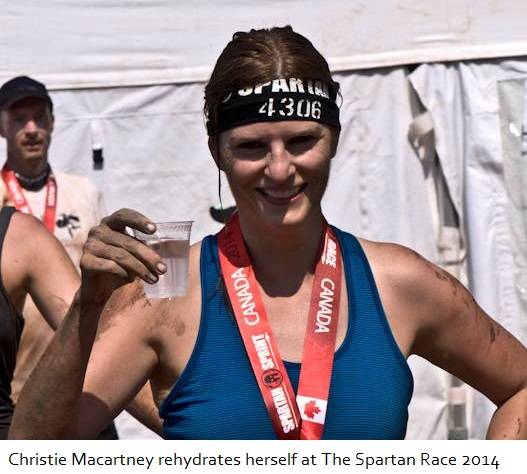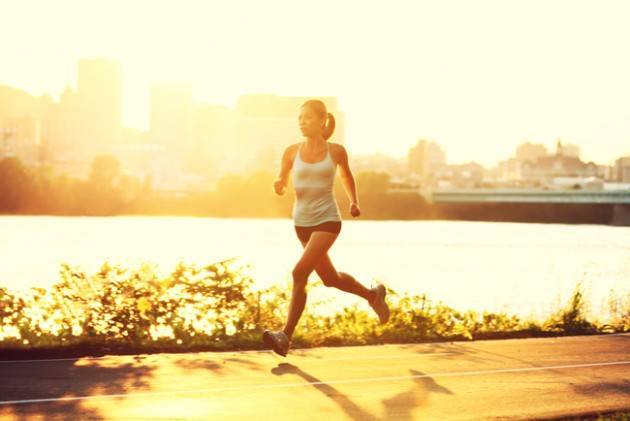Exercising in the Blazing Heat
Tips and Tricks for Summertime Workouts
By Christie Macartney
When the summer hits hard, the humidity can be quite hard on the body and it’s very important to be safe and prepare how to eat, when to exercise, what to eat especially if you want to work-out in the heat.
It was only four weeks ago that I completed the Ottawa Spartan Race, a 5K run and obstacle course up a steep downhill ski resort. The forecast for the day was 31C with a humidity way beyond expectation. As a personal trainer and nutritionist I began planning 48 hours prior to the event drinking 100 ounces of water and eating small meals every 2 hours. The forecast for the day was 31C with a humidity way beyond expectations.
I began hydrating early as my start time was 1:30pm, prime time for heat and humidity. By adding in Isagenix Energenix to help facilitate extra electrolytes in preparation for the heat I knew that I would be set up for success. I should have packed my running belt to hold extra fluids. During the race I had to stop multiple times to catch my breath and allow my heart rate to slow. With the extreme heat and persistent sweating I was losing water fast.
 Post-race I found out that many people were unable to complete the race as a result of poor preparation. If racing with a group it’s often the team that helps to support anyone if they are low on water or need motivation to continue. Lack of preparation can result in a poor finish or to the point of heat exhaustion. Given any extreme heat conditions, be safe and never hike or workout alone.
Post-race I found out that many people were unable to complete the race as a result of poor preparation. If racing with a group it’s often the team that helps to support anyone if they are low on water or need motivation to continue. Lack of preparation can result in a poor finish or to the point of heat exhaustion. Given any extreme heat conditions, be safe and never hike or workout alone.
A Spartan Race or marathon may not be your idea of a workout, but the key to a healthy workout entails planning and also to gauge what is best for you, is it a good day or should a basic walk in the park be perfect given the conditions. Even emotional stress can inhibit the body’s ability to adapt in extreme conditions. Understanding how the body works and know your personal limitations are known as YOUR internal guidance system.
What’s interesting is the dynamics of our bodies and its ability to adapt naturally to the environment. The internal regulating system naturally works to keep it cool by sweating. When the body begins to release sweat this also means the body is losing fluid. As the body continues to sweat without replenishment it will reach a tipping point where the core temperature begins to rise putting the central nervous system and internal organs at risk. This will lead to heat exhaustion or heat stroke.
Sign of heat exhaustion can include dizziness, nausea, fatigue, muscle cramps and weakness. A body temperature over 104 will results in the inability to sweat and potential acute respiratory distress, loss of consciousness, known as heat stroke which can lead to death. The intention here is to keep you informed, reduce risks and stay active during hotter days when possible. By continuing to replace the fluid loss by keeping hydrated with water, the body can naturally continue to keep cool.
If you live in an area where high temperatures are normal then your body has acclimated to the weather. However, if you are participating in a local event where the temperatures reach above normal heat ranges that your body is not used to, I strongly recommend preparing the body by either working out in higher temperatures during the middle of the day. Another way to acclimate is to visit the region a week a head of the planned event or adjust accordingly to how you feel if you are planning a regular workout session.
General hydration guidelines recommend that individuals consume at least 17-20 ounces of water two to three hours before exercise, 7-10 ounces of fluid every 10-20 minutes during exercise, and after exercise consume 16-24 ounces of fluid for every pound of bodyweight lost during exercise. So jump on the scale and note your weight before and after your workout to make sure you’re as hydrated as you should be after exercising.
If you become dehydrated and “thirsty”, your body has already reached a 1-2% dehydration state. People most often realize that how hot it is during a workout when it’s too late.
10 Tips to Keep Your Workouts Safe during the Summer Months
1. Consult your doctor and trainer if you are changing your workouts to include locations where the temperature is greater – prescriptions can intensify the effects of heat-related illnesses, caffeine, alcohol,
2. Workout early in the day or later in the evening when the temperature and humidity will be less
3. Acclimate to the new environment by giving your body a few days to adjust
4. Hydrate using water belts,
5. Adjust to the conditions with lighter clothing and use Sunscreen
6. Reduce the intensity of the workout and slow down the pace
7. Plan the route and the training area that has shady areas, reduced polluted areas and train with a friend
8. Assess the temperature the day before
9. Nutrition – coconut water, water and additional carbohydrates prior to training will help to meet expenditure needs.
10. Prepare to wear a heart rate monitor regularly – gage the change in heart rate. If your heart rate rises past your personal average levels then you may be pushing it too hard.
Consider the consequences of training in extreme heat. Given a 75-90 degree environment, as the body’s internal temperature rises, the heart will naturally beat about 10 beats per minute, rising faster than normal. At levels higher than 90 degrees—the heart beats even faster.
A great way to gauge water loss is to weigh your-self prior to the workout. Water loss greater than 2 percent reveals that the body is in a state of dehydration. The key to exercise in the heat is preparation. Nutrition, hydration, clothing, timing, intensity and fitness level all need to be considered. At the end of the workout you want to feel a sense of accomplishment rather than dizziness or nausea.
“It’s no coincidence that the first four letters in the word health are “heal.” – Ed Northstrum
What hot workouts have you tried? Share your experiences.
Here’s to great health,
Christie
 The Global Calcuttan Magazine
The Global Calcuttan Magazine 